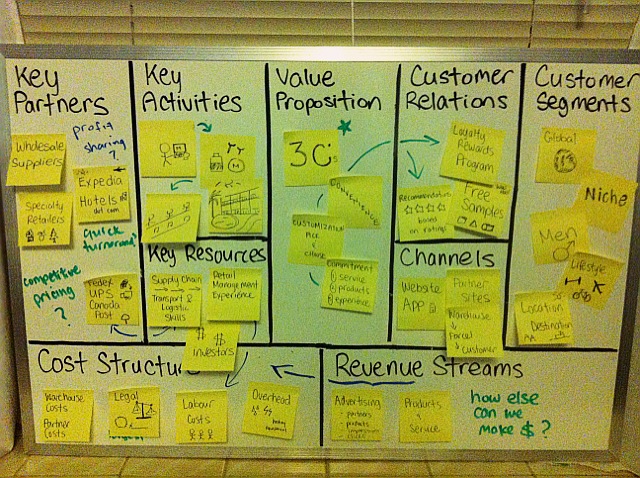I am never without pen and paper. My thinking process starts with an idea. I jot down my ideas each day, going through them every few days, and edit as I go along. The ideas slowly turn from words into sentences. It is an iterative process that takes time, but it usually does not require a lot of effort. I let my ideas flow freely (similar to the free writing exercise), without really forcing anything. I find writing is both a therapeutic and an introspective process for myself. I use this method to write essays and complete assignments.
However, I tend to run into problems when a task is time sensitive and requires immediate results. I’ve learned to be adapt my thinking process to become more strategic in solving these kinds of problems. Take, for instance, the “Business in a Backpack” activity. We were given 30 minutes to ‘rapid prototype’ a new business concept with a partner. On a piece of paper, I quickly mapped out our belongings, interests and skills. I used lines to show where our resources were similar and left spaces where we were different. We also discussed our love of traveling and how we could simplify the process. We funnelled our ideas down on the map and eventually came up with the Man Kit. The Man Kit is essentially an online, one stop shop for men to order their favourite toiletries before their trip, and have it waiting for them at their destination.
Business Model Canvas
Here’s a photo of applying the Business Model Canvas on the Man Kit:
I decided to practice using the Business Model Canvas on the Man Kit. I loved the flexibility of the canvas and how I was able to create a visually appealing, macro view of the company. I was able to draw links between the building blocks and was able to ask questions where I lacked information. The canvas was easy to edit and expand, and is very similar to my pen and paper thinking process.
Field Trip
When we visited our client DimeRocker, we brought along the Business Model Canvas in hopes of understanding their business model better. The CEO, J. Joly, provided us with a glimpse of his company and helped us fill out the building blocks. J. also surprisingly remarked that they use similar models on their walls. We quickly looked around and realized what he was talking about. Walls were decorated with colourful Post-it timelines and charts. The charts were dynamic, macro shots of current projects and inspirations.
Design Thinking
Traditionally, companies excelled at the creative or analytical sides. Both Thomas Lockwood and Roger Martin stress that companies need to think from both perspective in order to stay innovative. Companies such as Proctor & Gamble and Apple have embraced innovation, recognized it as a continuous process, and have significantly surpassed their competitors. Many people, including myself, may have a preference for left or right brained thinking. I am usually quite impulsive when it comes to brainstorming, spitting out ideas as they come, but I’ve learned to become more critical and strategic in my thinking process.
I’m open to and excited to try out the different design processes in Comm 388. I want to discover what combinations of thinking strategies and techniques will be most appropriate to use in different situations.
-Jackson


Recent Comments